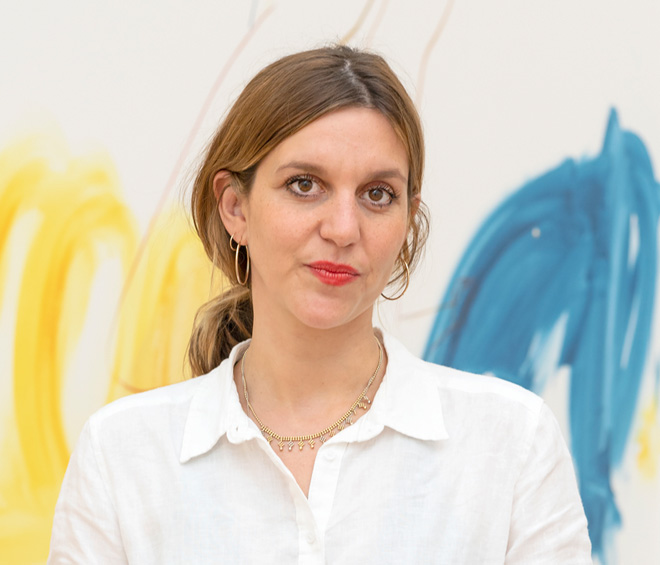
France-Lise McGurn. Photo: Tate Photography.
by CHRISTIANA SPENS
The work of Glasgow-based artist France-Lise McGurn (b1983) – paintings whose figures escape their frames to overlap and bleed into one another across the walls of the gallery – explores the closeness and strangeness of city life. Her latest works, now on show in Sleepless at Tate Britain, reflect, in particular, on states of sleeplessness, and how various experiences of it have inspired and changed her artistic practice. Here, she talks about motherhood, hedonism and the clashing spheres of intimacy and strangeness in Glasgow, Berlin and Ibiza.
Christiana Spens: Can you tell me a little about your ideas behind the title, Sleepless? In particular, how have your experiences as a new mother changed your thinking about sleep, sleeplessness and being awake in the middle of the night?
France-Lise McGurn: I make so much of the work in situ, so the title of the show has to be a really broad title. It has to be something that has movement or a feeling rather than a narrative or anything didactic because it has to bracket so many different things, and I have to be able to move inside it. At the time they asked me, I was in the thick of the sleep deprivation of new motherhood and was reflecting on earlier times in my life when I used to party a lot, and how that had come into my work as well.
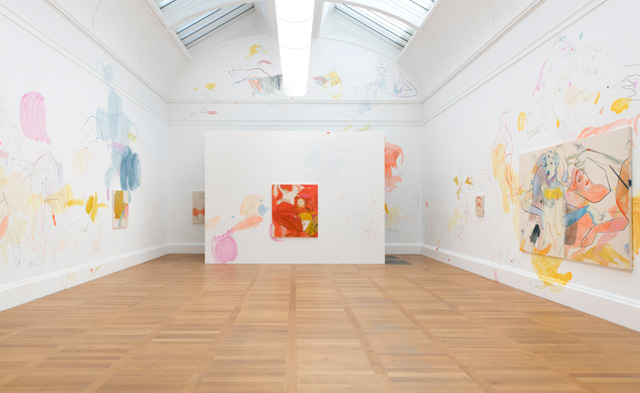
Art Now: France-Lise McGurn: Sleepless, installation view, Tate Britain, London, 2019. Photo: Tate Photography.
I was lying awake at night constantly for the first six months and I was thinking of it as a state of mind and a sort of half-consciousness, a sleepwalk. But I chose “sleepless” rather than another version of that word because it’s not meant to be a negative thing like: “I’m sleep-deprived.” It’s not a moany thing, it’s just a certain state of mind, like a twilight, and I wanted that to underline all of the work, because I was making the studio work at the time as well.
I really liked the kind of trashy reference to Sleepless in Seattle, because a lot of the figures [in my work] I see as personifications of feelings. They’re not a specific subject; they’re not a direct appropriation of something. I see them as thoughts or embodiments of a certain movement or feeling. I liked the idea of Sleepless in Seattle as a personification of a place, or a name for a certain state of mind. It tied in, in a few different ways. I thought it was enough of an opening just to be able to work inside it. Having to create work at the same time as being sleep-deprived also fed into a really specific feeling of claustrophobia or anxiety that the title could frame as well.
CS: Well, you’re in the house a lot in the early days, and that feeling of being stuck in the bedroom … it was winter when I had my son, so it felt like hibernating, inescapable.
FM: Same here! I remember at one point, in the first two weeks, when it’s really mental – going to the bathroom and it being really a panicked thing to do – and it was colder in the bathroom because we were keeping the bedroom really warm for the baby, and being in the bathroom and being freezing. It was a bit like when I’d gone to the bathroom at a party, and suddenly realised I should go home: “I have to get back, hurry, hurry” –that panic, because you don’t feel you can be away. I think all of that – I don’t want to talk about dream imagery and that, but it does affect this half state of mind.
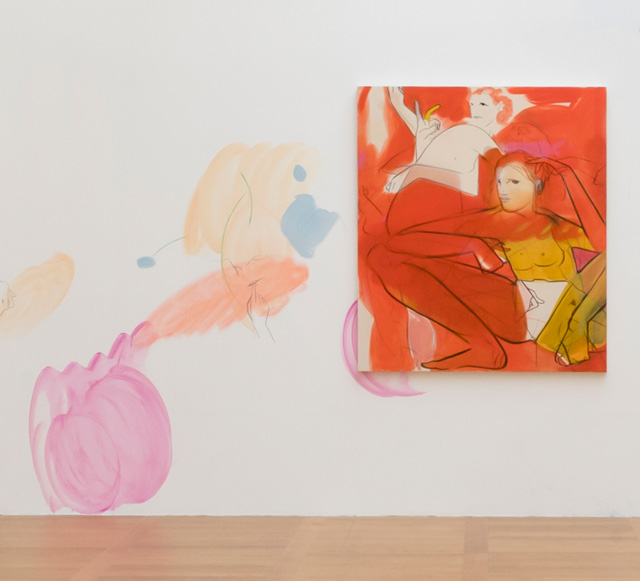
Art Now: France-Lise McGurn: Sleepless, installation view, Tate Britain, London, 2019. Photo: Tate Photography.
CS: Yeah, it is crazy. And it is funny because it is an experience that people refer to a lot but it isn’t represented very often, in painting or anywhere else. How did you find that it came into your practice?
FM: I think because I was making the work on autopilot almost, [the body of work] became itself this energetic thing. If I’m honest, although I still managed to paint a lot, the thing that changed so much in doing studio practice was cutting the time that I’d normally spend “researching” and just allowing myself to deviate into certain books or materials, or the internet or whatever. That was cut quite a lot, so it was really like using that energy of sleeplessness itself. It became this pure energy. I felt I was impulsively working on the paintings and that they had to be more instinctive or intuitive than normal.
CS: Is there some added nostalgia for the old days of going out that is also more prominent now, or has changed in some way?
FM: Yes, maybe initially as quite a nostalgic thing, being quite frustrated, not wanting to go out exactly, but realising you’ve changed. You’re never ever going to want to be so wrecked that you can’t take care of that baby. Maybe I will [laughs] – you can maybe fill me in on what to expect in the next few years! But it’s not a desire for abandon any more; I’m going to want to retain some sense of control. I feel that’s quite an identity shift as well. In the past few years I’d been going out less anyway, so it’s not like I longed for it. But it’s more that there’s no going back now. And that’s a nice feeling, because you don’t have to do that again. Or, I never will be lost there in the same way again.
CS: Do you think it is having purpose as well? I mean, you would have other kinds of purpose, of course, but feeling always as if you are floating around and wanting to have more of an anchor, and motherhood gives you that, whether or not you always want the gravity of it. It gives you a different sense of purpose, which is in itself a huge shift.
FM: Yeah, I think that’s it – it’s not feeling lost not just in terms of abandonment, but also in what to do with yourself. Going back to the way things were isn’t an attractive prospect now. And then you’re on a different plane, anyway – I mean I’m from Glasgow, so Glaswegians have a specific rep, so all my pals were still going out. I’d hear from them when they were being wholesome during the weekdays, and then just sign out all weekend, and then come back in to check on them again. I was watching the different cycles as well, and some I’m not part of any more.
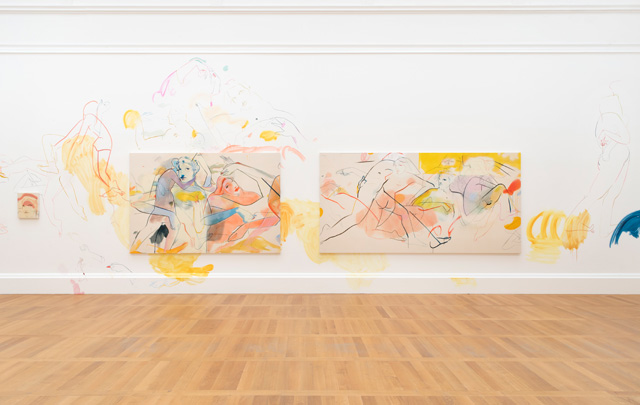
Art Now: France-Lise McGurn: Sleepless, installation view, Tate Britain, London, 2019. Photo: Tate Photography.
CS: It’s interesting going into the idea of the city as well, that you are already aware of there being so many worlds going on at the same time, and that’s always the case, but, as you say, there is a world that you can go in and out of to some extent, but you are inhabiting a very different world now, which other people don’t have insight into. It is as if we are on different planets.
FM: Yeah, and that reminds me of lying awake in my bed one time, in the early days, and sometimes I’d feel I could hear my neighbour move against the wall, like they were trying to get into my bed. I felt really squashed, by everyone around me, but I also felt they were in a totally different world, like you say, they were in a different time and I was totally isolated in mine.
CS: Do you think this sense of claustrophobia (and with it, disorientation) was an influence in choosing to paint outside of the canvases, and showing that tension between being in a frame and being out of the frame?
FM: I think it’s maybe not a conscious thing, but definitely – I only started painting on canvases about five years ago. It took me ages to get into painting within a frame, on a canvas. I think that’s why I also don’t prime them with white. That way they’re a bit more throwaway, they don’t carry that heavy weight of the canvas structure, but it took me ages to work on that and the only way I can – not so much now, it’s changing, but to leave the rawness of the canvas means it’s open. I’ve always liked stuff that looks a bit rough around the edges, or a bit throwaway, like notes. A lot of the stuff I collect is notes of plans or sketches and stuff like that. I really like handwritten materials. And I think that it’s all symptomatic of the same thing, which is that I’m really quite impatient and I work really fast, so I don’t want to labour on anything else.
CS: I suppose it’s the ephemerality of it as well; it fits the subject in that way.
FM: Yeah. Labouring one image, I find that really difficult, and it’s not what I need from the image, it’s not what I need to get from it. It’s not animated; it’s not got the same directness that I want. I think that there’s always a bit of that feeling.
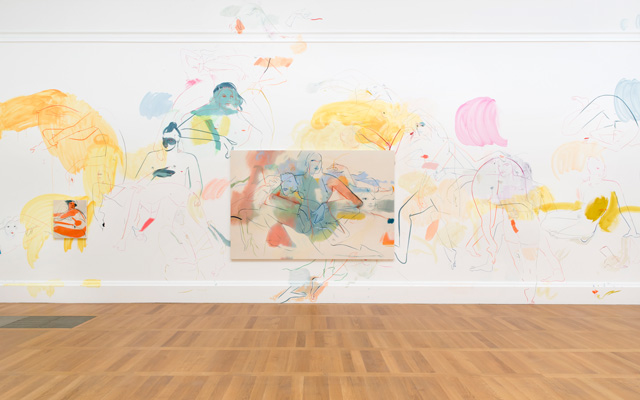
Art Now: France-Lise McGurn: Sleepless, installation view, Tate Britain, London, 2019. Photo: Tate Photography.
CS: Your work seems to explore ideas about consciousness and unconsciousness, dreaming and an in-between world. While typical experiences of clubbing and hedonism are evident, are there also links to pregnancy and infancy, perhaps, when babies seem to exist in between these worlds very naturally?
FM: I hadn’t even thought of it that way, but I guess your pattern mimics their pattern as well and so you’re seeing sleep – it’s free isn’t it? I mean some people regiment it, but at the beginning they sleep, they wake, they sleep, they wake, it’s all one. And you’re with them, you also share that pattern. You realise that there are so many natural restrictions on how we sleep. When are you ever asleep in a room with lots of people around you? On people? There’s something about that idea of sharing sleep as well, being asleep and being in company, but that’s so reserved for a certain time and being alone and everything’s all in its place. But when you’re sleepless, when you’re sleep-deprived, when you’re mothering at the beginning, all those things turn on their heads and the normal systems don’t fit any more.
CS: Your work is also about the experience of living in the city. Since you grew up and live in Glasgow, presumably this is specifically about this city. What is it about Glasgow that comes through in your paintings?
FM: I’m Glasgow born and bred, but because I didn’t study in the city, I feel I sometimes have a different experience of it than most Glasgow-based artists. A lot of the artists I know here studied here and that’s how they met each other and formed whatever they formed. But I left when I was 17 and only properly came back about six years ago. It was when I was down in England last year [for the Tate’s touring Virginia Woolf exhibitions] that I realised this is really a certain view of England that I don’t relate to at all. And I just realised so much by being there that I’m not from this, that I am very Glaswegian, and that my work is. I’d never thought before, because I haven’t directly made work about it, but I think I’ve got a certain aesthetic that’s rooted in 1990s Glasgow.
I was trying to pinpoint what it was about Glasgow that had had a massive influence, and where that aesthetic really came from. There’s this idea that Glasgow’s really violent, which it is in parts – like most cities in the north. Anyway, my dad, who is an architect who also lectures at the Glasgow School of Art, gave a really excellent lecture about growing up in the city, and then going into city planning and architecture. He said that one of the reasons Glasgow was so violent when he grew up was that there was so much lead in the water, so everyone was sharing this water, drinking it, revved up on lead! There was this shared intimacy in that. Even now, it’s this idea of a shared feeling, rather than just shared violence. Shared chemicals, substances.
CS: And that links into your paintings about clubbing, presumably? In which there are other shared feelings and substances.
FM: Yes! And here people are quite rogue and there’s a big after-party scene, and also, because we’re not allowed to buy alcohol [in shops] after 10pm, it makes everybody club together and go to each other’s houses. You can’t go anywhere else. It’s like in Berlin when I lived there, and you would meet someone and it was: “Yeah, I was at that club, but I was there at 5am, and you were there at 1, oh no.”
CS: When I went to Berlin I was a bit disappointed. It felt very subdued.
FM: Yeah, because it’s really sensible Germans, even if they are in the club at 5am. Whereas here it’s too excited, and then too drunk, and staying up too late – then having a breakdown, obviously.
CS: Would you say that places such as Ibiza and Berlin have also been important in this series?
FM: Yeah, definitely. Ibiza, by proxy almost. I got really into the idea of – I think one time I was going to see Lucy Stein in Spain and we passed the Benidorm sign – and the “B” had fallen down and it was just hanging there. I was thinking about these abandoned “utopian” places and then reflecting on my own life – how there are the glory days of going out and then how that changes.
I was also thinking about Berlin, and how after I left people would always ask me if I missed it, and I just thought it was exactly like a bad boyfriend. I always wanted to do a show called The Bad Boyfriends, actually – London, Berlin, whatever – because I loved them at the time, but really, when I thought about it all later …
CS: It’s weird when you think everything of someone and you’re obsessed and then, later, it’s just repulsion, or worse perhaps, indifference.
FM: Yeah just like, why was I so caught up in that, and thought that was everything? And why did it define me? And then you’re out of it and it doesn’t even matter. In a similar way, Berlin doesn’t even cross my mind that much. It was a really weird experience of like a pure lost city. I spoke to a friend about it once and we were calling it the wilderness years, and he said: “Yeah, but that’s what it’s there for. You go out there, you make a mess for three years, and then you come home. That’s what it’s for!” I was like: “Oh, right. That’s what it’s for!” I didn’t know what I was doing when I was out there! I didn’t do anything. I thought I was going to the studio every day, I thought I was making work, but I made nothing. I was hungover, I think.
CS: Maybe you just need time like that. You can’t always be doing everything.
FM: No, I’m glad, I’m really glad I did it. It feeds into my work now anyway.
CS: It’s the reputation of it as well: people ask what you’re doing and you say you’re in Berlin, and they assume there’s a point to it.
FM: I think it’s a way of getting out of doing anything. People ask what you’re doing and you say: “Oh, I’m moving to Berlin.” “Are you doing any exhibitions?” “I’m moving to Berlin.” It’s something to do. I was working as a waitress here and I thought I might as well go, I’ll learn a language at least. But I didn’t, of course.
CS: You paint these groups of figures who overlap and escape their frames and the lines of their own bodies. Do you think about group identities when you are working, or how it feels to be an individual in a group of people, whether known or strangers?
FM: I really feel connected to the idea of congregations of people. It can be riots and protests, or clubbing and gigging. The way I want my figures to be read is the same way you go to a club and you know there are figures there, you know that you’re with people, you’re dancing with them. It’s quite an intimate exchange, and you’re losing your inhibitions with somebody, but most of the time it doesn’t matter who they are, it’s all just part of the whole.
CS: Do you think that’s similar to what you were saying about ex-boyfriends – you have these intense experiences and all the rest of it – but in the end they could be anyone.
FM: Yeah, it’s really true. I feel that way about the figures in the work, too. They’re not supposed to be about a specific figure or person. They’re symbols, icons, things to project on to. They’re a feeling or a thought and they embody that. And I want them to be read all together, which is why they come out of the canvases. It doesn’t matter about any one individual in the room. For me, the paintings on the walls, on the canvas, the figures have the same presence, or they should do.
CS: Do you think it adds a sense of claustrophobia as well, having these almost mask-like, similar, faces. Almost something sinister or unnerving.
FM: There is a sense of vacancy sometimes. I’m not doing these very emotional works.
CS: Do you think people expect figurative art to be like that?
FM: I’ve always got a bit of a weird relationship with figurative painters. I love figurative art more than I’m drawn to any other form or style, but I do feel that sometimes abstract painters and I can talk in the same terms, about rhythm and stuff.
CS: Do you think it’s just about different kinds of emotion? I always associate figurative art with very passionate forms of emotion, but there are all these other emotions and feelings, such as dissociation or feeling uncomfortable, that are maybe slightly underrepresented. It’s just that you’re including those.
FM: Yeah, and that’s where it begins to relate to my own experiences and perspective because I always steer away from talking about Picasso and so on. I’ve had people ask me: “Why are you using the language of the male painter?” I’m like: “What?! I’m not doing any of the same things that they’re doing, or were doing.”
CS: You could say that about any form of art, anyway, because there’s always been a male artist who has done it first.
FM: That’s true, exactly. But I think when people aren’t making stuff, they think that you’re really conscious, with real intent, but it’s just the way you work, the way you’re going to do it, and there’s no getting around that. That was always the way I was going to work. It could shift, but I’m not suddenly going to start making really cerebral work or conceptual art. You have to do what’s natural to you.
• France-Lise McGurn: Sleepless is at Tate Britain, London, until 8 September 2019.
 Eadweard Muybridge: Shaping and Shifting Our Point of View
Eadweard Muybridge: Shaping and Shifting Our Point of View
 Rewinding personalities: Van Dyck at Tate Britain
Rewinding personalities: Van Dyck at Tate Britain